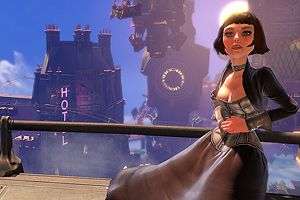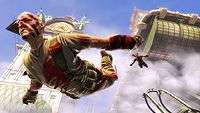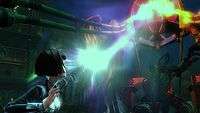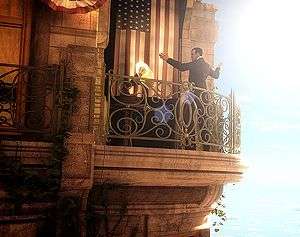BioShock Infinite – E3 Preview
by Lorna
|
In August 2010, what had been known as Project Icarus finally took flight and Irrational Games unveiled their new project: BioShock Infinite. With the creative force of Ken Levine back at the helm, almost five years after the original BioShock, the game appeared to be in safe hands and the trailer and concept sparked immediate attention, not least because of the eye-punching setting.
Despite not being an FPS gamer, the unique floating city of Columbia grabbed my attention and refused to let go, which is why I became determined to track it down at E3 and see what more I could glean about it. The half hour presentation was a strong one, reinforced by the period theming in the small room, and truly showed off the dystopian beauty of the game’s environment along with the, often frenetic, gameplay.
When the game was first revealed, some gamers may have been disappointed to find that it would be yet another BioShock title, however, Ken Levine has been keen to stress over the last few months that BioShock isn’t about the drowned city of Rapture – setting for the first two games – but rather, an overall concept. Infinite is just one more story set in the BioShock universe. While the lofty setting is, literally, miles apart from the underwater location of the first two games, Infinite has the same ‘Bioshock feel’, sharing many similar ideas. Themes of hope, idealism, and ingenuity which fall prey to power and corruption, ultimately plunging a once powerful, idealistic world into violent disarray are all familiar.
Rapture was a hidden city, but Columbia is more of a lost, missing one. Created at the turn of the twentieth century, Columbia is described by the developers as a ‘flying world’s fair, carrying the dreams of US idealism and expression’, taking the form of a vast, lush metropolis, suspended by giant blimps and balloons. Before Uncle Sam muscled in, Columbia was an iconic symbol; the female personification of the United States, and she is emblematic of the city in not just name, but also the look and neoclassical feel to some of the architecture. Of course, the innovation and idealism behind Columbia hide more sinister things, and it is, in fact, fully armed. After a violent incident, which takes place some time before the game commences (set in 1912), the US disavows Columbia and it drifts off, vanishing and becoming lost among the clouds, like a sort of Steampunk Death Star.

The floating city in all its glory, blending a retro-futuristic Steampunk feel with tattered American nostalgia
Irrational Games seem to excel at creating ‘broken worlds’ – far from being anything in the negative sense – they take extraordinary, fantastical, yet oddly believable places that are hopeful, bright, and based on strong or worthy ideals. Then they break them down. They pull at the seams; wear and degrade them, scuffing and muddying them like a child with a new toy in a sandbox, allowing them to become victims of corruption, to be tainted with violence, and then, only then, do they let the player loose into these sad, dangerous playgrounds.
 With BioShock Infinite, this is as clear as it was with the first game. Columbia has become warped, succumbing to the heavy corruption that only power can bring and split into warring factions against a backdrop of xenophobia, and quest for ‘purity’ above all else – echoing the footsteps of our own grim history. The city is governed by the Founders, the elite ruling class, who seek to deny foreigners the same rights and privileges as Americans, and who are responsible for the air of xenophobia and ideals of racial purity now tainting the city.
With BioShock Infinite, this is as clear as it was with the first game. Columbia has become warped, succumbing to the heavy corruption that only power can bring and split into warring factions against a backdrop of xenophobia, and quest for ‘purity’ above all else – echoing the footsteps of our own grim history. The city is governed by the Founders, the elite ruling class, who seek to deny foreigners the same rights and privileges as Americans, and who are responsible for the air of xenophobia and ideals of racial purity now tainting the city.
The developers have stated previously that, while the concepts of jingoism are present, they are there more to set the stage on which the stories of the characters will play out, rather than take over and become the sole focus. To illustrate this, the team have produced some incredible artwork, some of which will appear in-game. Propaganda posters litter the city, espousing alarming notions; one reading “We must be vigilant to ensure the purity of our people.” Under this rule has sprung the other primary faction that Booker finds upon entering the city, namely the Vox Populi. While once they stood and fought for the rights of all, for equality, they too have been corrupted by power and now exist as brutal, violent activists who have lost sight of what it is they are actually fighting for.
 The story of our protagonist, disgraced Pinkerton agent, Booker DeWitt is played out against this backdrop, as he is tasked by some mysterious individuals to enter Columbia and rescue a young girl named Elizabeth, who has been trapped in the city for the last 15 years. Getting up there is seemingly easier than reaching Elizabeth and then hanging onto her, however, as she is, for some reason, at the centre of the conflict tearing Columbia apart. Not only that, but she is watched over by a giant, mechanical bird, known as Songbird, who has been her watcher and constant companion all this time… and Songbird will hunt the pair of them down.
The story of our protagonist, disgraced Pinkerton agent, Booker DeWitt is played out against this backdrop, as he is tasked by some mysterious individuals to enter Columbia and rescue a young girl named Elizabeth, who has been trapped in the city for the last 15 years. Getting up there is seemingly easier than reaching Elizabeth and then hanging onto her, however, as she is, for some reason, at the centre of the conflict tearing Columbia apart. Not only that, but she is watched over by a giant, mechanical bird, known as Songbird, who has been her watcher and constant companion all this time… and Songbird will hunt the pair of them down.
Elizabeth’s past and relevance to the conflict has been kept under wraps, but it will likely have much to do with the strange powers she possesses. She neither understands them or their origin, nor can she control them, and this is where the gameplay demo came in, with Elizabeth refusing to leave Columbia until she finds answers and learns to control her powers. Believing the leader of the Founders to have the answer, they set off for Comstock Tower through the expansive city.
In one of the first scenes demoed, we see Elizabeth playing, trying to attract Booker’s attention while he explores their surroundings. Possessing a playful, child-like nature, you’d be forgiven for thinking that she is unaffected by the violence around her, but one look into her huge, beautiful eyes tells of something more. They are haunted, sad, balancing her power and poise with a sense of fragility and vulnerability; this likely stems from the enigmatic Songbird. At first we only hear the creature and witness the destructive capabilities that it possesses, but this later changes. Elizabeth is in both fear and dread of her former keeper, making Booker promise, in a sobering scene, to kill her rather than let her be taken back. While he assures her that “it won’t come to that”, the fact that she’d rather die than return to her captor is both intriguing and unsettling, but instantly pulls the player in and opened up the relationship to my curious mind.
Her powers are central to the game’s element of player choice – something which should be familiar to players of the previous titles. Whereas before, your actions and decisions (and the consequences which arose from them), largely hinged around the Little Sisters, here it is how (and if) you choose to utilise Elizabeth’s powers. Every time she uses them, she struggles to control them and it drains her, seeming to cost her greatly. While they have much to offer, you – we witnessed her wrenching a foe from behind cover to allow Booker to put a bullet in him – you have to decide, as a player, whether you want to risk her. Her powers are more involved than just ranged effects, however, and Elizabeth seems to be able to open tears in space and time – something we witness as she desperately tries to save a dying horse. Whether these will allow for a new gameplay dynamic I don’t know and it wasn’t shown, but the possibilities are certainly there.
Once Booker and Elizabeth step outside, we get a chance to truly appreciate the city and, to be honest, it is stunning. While it moves away from the Verne-esque retro-futurism of its predecessors, the bright American nostalgia, mixed with future-tech is very much present and it makes for an intriguing setting. At once the eye is assailed by colour – gone are the more subtle palettes of the previous games, and in are bold, primary colours, evoking optimism and hope beneath an impossibly blue sky. Towering buildings boast rows of columns and impressive architectural character, overlooking verdant parks full of flowers, which serve to break up the urban feel of the city and lend it a comforting, light feel. Everywhere the player turns there are details to be savoured; banners stirring in the breeze, proud statues, posters, and more. I found myself scribbling blind at one point, unwilling to look away for fear of missing anything. Up close, however, thanks to detailed textures, Columbia’s grandeur begins to fade, with scuffs and pockmarks marring the frontages, telling of the undercurrent of civil war and unrest and almost mirroring the governmental rot.
 As Elizabeth and Booker head for Comstock Tower in search of answers to Elizabeth’s mysterious powers, we run into the Vox Populi, murdering and looting, and around the plaza lays the disturbing evidence of public executions for, seemingly, ridiculous crimes. Of course, it isn’t long before we’re pulled into a fight and here is where the game exploded in pace. A gunfight with the Vox breaks out and Booker is forced to take them out, utilising Elizabeth’s powers along the way. The action is smartly paced, but this was nothing compared to the demonstration that we were about to receive of the game’s new feature: the Skyline.
As Elizabeth and Booker head for Comstock Tower in search of answers to Elizabeth’s mysterious powers, we run into the Vox Populi, murdering and looting, and around the plaza lays the disturbing evidence of public executions for, seemingly, ridiculous crimes. Of course, it isn’t long before we’re pulled into a fight and here is where the game exploded in pace. A gunfight with the Vox breaks out and Booker is forced to take them out, utilising Elizabeth’s powers along the way. The action is smartly paced, but this was nothing compared to the demonstration that we were about to receive of the game’s new feature: the Skyline.
The Skyline is like a multi-layered rollercoaster which sweeps through the city among the buildings and over dizzying drops into infinity. Booker has a wrist gadget which acts as a grapple, allowing him to grab the Skyline and ride beneath it like a carriage-less coaster train. What had originally been intended by Columbia’s founders as a means of transporting cargo, later evolved into passenger transport, and now a superb theatre of battle. Booker can at once take the high ground, playing tactically to flank the enemy and rain down attacks as he flies between buildings and over parks at breakneck pace. If you get motion sickness, you’re on your own because the pace is as breathtaking as the view as Booker swirls over plazas and treetops like a drunk glider, out over gut-kicking drops through the clouds, firing on enemies who can (and will) also utilise the Skyline to their advantage, making for some great moments of aerial combat.
 |
 |
 |
||
 |
 |
 |
||
 |
 |
 |
When we finally return to Elizabeth, we have an even bigger issue to deal with: the arrival of Songbird. It is in this scene that we get to see the stalking menace and witness first hand, the complex relationship between it and Elizabeth. Fear and hatred seem to mix with the oddly close bond she shares with it and Songbird itself is deeper than it first appears, with a hint of something approaching jealousy in its actions. This comes across in its punishing of the runaway girl by threatening the death of her erstwhile saviour. Elizabeth’s desperate apology is the only thing that saves Booker, and gives her relationship with the creature an oddly spousal one. She appears like a treasured possession to it; gently cherished, but controlled, utterly, with harsh consequences for disobedience. She in turn may hate it, but there is an air of ‘Stockholm Syndrome’ there too. Of all the things I saw at the presentation, I think this relationship piqued my interest more than anything.
The half an hour presentation flew by as fast as Booker on the Skyline and when the lights were raised, I was still struggling to absorb it all. The expansive cityscape of Columbia is breathtaking and the open-air environment is a riot of colour and character, begging to be explored. And that’s not all, with the protagonist no longer silent, and the mysterious Elizabeth and her pursuing ‘watcher’ as key parts of the narrative, there is also much to be explored in terms of character and story – something the BioShock universe does so well. I came away certain that it would be my personal game of the show, and this opinion remained unchanged. With the complex backdrop, crisp, vivid visuals, and absorbing story, the 2012 release can’t come soon enough. It may have Move support for the PS3, as announced at the Sony conference, but I could care less – for me, it is all about the setting and story. The broken down, dystopian vision of American hope and innovation is a compelling setting and one that is almost as fragile in its way as the mysterious young girl we’ve been charged with saving.
BioShock Infinite is on course for a 2012 release.
Games featured in this article
For more information on any of the games featured in this article, click on any of the links below
Last five articles by Lorna
- Flagging Heart
- Where Have All the Hours Gone?
- I Heart... Overlord
- Life Goes On: Done to Death - Review
- Welcome to Spoilerville, Please Despise Your Stay
































Can’t wait to try the Skyrail out for myself and Elizabeth is fast cementing herself as one of my favourite game characters, bootiful!
Has an art style I can’t get enough off either, no bland grey, brown or beige, a refreshing change.
It looked stunning when I saw a video of it many moons ago. It’s a game I’d love to watch somebody play though I’ve never gotten into the franchise myself.
Oh man, you had me on the first sentence and now I really, -really- want to play this game xD Great preview, the game sounds epic!
Lorna, holy shit, Lorna.
This was incredible, and I’m now fidgeting massively knowing I have to wait until next year. All the information you’ve provided is news to me, and it’s done nothing but make me even more excited for this game. I can’t wait now, and it’s all because of you
Darn you!
Had this down as my one to watch prior to the show and this only stokes the anticipation more.
This is what Bioshock 2 should have been. The more I see and hear, the more amazing it sounds. It’s like they took the classic Studio Ghibli animation ‘Laputa – Castle in the Sky’ and went to the extremes of the concept. You still have the lethal flying fortress wandering the world’s atmosphere beyond the control of any government, the Steampunk setting, and the beautiful young girl with incredible powers. But the whole thing has been plastered with that Bioshock treatment and the whimsy and fantasy made dark and sinister.
I can’t wait for this game.
Awesome write up Lorna.